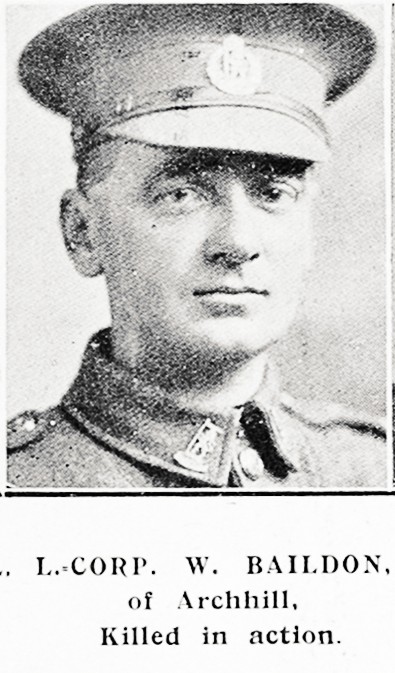L/Cpl
William Baildon
Informatie over geboorte
|
Geboortedatum: 22/06/1885 |
|
Geboorteplaats: Auckland, Auckland, Nieuw-Zeeland |
Algemene Informatie
|
Beroep: Timmerman |
Informatie legerdienst
|
Land: Nieuw-Zeeland |
|
Strijdmacht: New Zealand Expeditionary Force |
|
Rang: Lance Corporal |
|
Service nummer: 53755 |
|
Dienstneming datum: 05/02/1917 |
|
Dienstneming plaats: Auckland, Auckland, Nieuw-Zeeland |
|
Eenheden: — New Zealand Rifle Brigade, 2nd Bn. (Laatst gekende eenheid) |
Informatie over overlijden
|
Datum van overlijden: 05/02/1918 |
|
Plaats van overlijden: Jubilee Croft, Beselare, België |
|
Doodsoorzaak: Killed in action (K.I.A.) |
|
Leeftijd: 32 |
Begraafplaats
|
Buttes New British Cemetery, Polygon Wood Plot: XIII Rij: A Graf: 16 |
Onderscheidingen en medailles 2
|
British War Medal Medaille |
|
Victory Medal Medaille |
Points of interest 3
| #1 | Geboorteplaats | ||
| #2 | Dienstneming plaats | ||
| #3 | Plaats van overlijden (bij benadering) |
Mijn verhaal
William Baildon was born in Auckland on 22 June 1885, son of William and Isabella Baildon. He had eight siblings.
William was a carpenter working for the Education Department in Dargaville (North Auckland) when he enlisted in Auckland on 5 February 1917, service number 53755. He was originally part of a NZ Brigade training company in the 28th Reinforcement but in April was moved to the 27th Reinforcement. He trained at Trentham and Featherston camps before leaving New Zealand on the troop ship Athenic on 16 July 1917. After a voyage across the Pacific and through the Panama Canal, William arrived at Liverpool on 16 September.
He continued training at Tidworth and Brocton camps in England before he sailed to France on 23 October and was posted to C Company, 2nd Battalion, New Zealand Rifle Brigade on 2 November 1917. He therefore missed the hard battles of October 1917 near Passchendaele. He was promoted to lance-corporal on 7 November.
After the Third Battle of Ypres the New Zealand Division held the line in and around Polygon Wood. In early December the Division wanted to improve its positions and tried to take the heights round Polderhoek Chateau.
The Division’s battalions relieved each other in the Polygon Wood sector, the main work being improving defences, repairing trenches and wire. The landscape was water-filled shell holes. The Germans had observation over much of the area so any movement was shelled or machine-gunned.
As with many of the NZ Division, William was involved in laboring tasks when not in the front line. On 20 November he was detached to the 1st Australian Tunneling Company which was building deep shelters for troops, spending three weeks with that unit.
The Rifle Brigade returned to the front line on 14 January 1918, the relief taking place in heavy snow. It was there until the 20th. After a short rest the brigade went into the line again on 1st February, with the 2nd Battalion in the front line. During this early February period there were heavy bombardments by both sides, with the Polygon Butte being a particular target.
It is likely that William Baildon was killed by shellfire near Jubilee Croft on 5 February 1918.
He is now buried in Buttes New British Cemetery in Plot XIII, Row A, Grave 16.
William was a carpenter working for the Education Department in Dargaville (North Auckland) when he enlisted in Auckland on 5 February 1917, service number 53755. He was originally part of a NZ Brigade training company in the 28th Reinforcement but in April was moved to the 27th Reinforcement. He trained at Trentham and Featherston camps before leaving New Zealand on the troop ship Athenic on 16 July 1917. After a voyage across the Pacific and through the Panama Canal, William arrived at Liverpool on 16 September.
He continued training at Tidworth and Brocton camps in England before he sailed to France on 23 October and was posted to C Company, 2nd Battalion, New Zealand Rifle Brigade on 2 November 1917. He therefore missed the hard battles of October 1917 near Passchendaele. He was promoted to lance-corporal on 7 November.
After the Third Battle of Ypres the New Zealand Division held the line in and around Polygon Wood. In early December the Division wanted to improve its positions and tried to take the heights round Polderhoek Chateau.
The Division’s battalions relieved each other in the Polygon Wood sector, the main work being improving defences, repairing trenches and wire. The landscape was water-filled shell holes. The Germans had observation over much of the area so any movement was shelled or machine-gunned.
As with many of the NZ Division, William was involved in laboring tasks when not in the front line. On 20 November he was detached to the 1st Australian Tunneling Company which was building deep shelters for troops, spending three weeks with that unit.
The Rifle Brigade returned to the front line on 14 January 1918, the relief taking place in heavy snow. It was there until the 20th. After a short rest the brigade went into the line again on 1st February, with the 2nd Battalion in the front line. During this early February period there were heavy bombardments by both sides, with the Polygon Butte being a particular target.
It is likely that William Baildon was killed by shellfire near Jubilee Croft on 5 February 1918.
He is now buried in Buttes New British Cemetery in Plot XIII, Row A, Grave 16.
Bronnen 1
|
Austin W.S., The Official History of the New Zealand Rifle Brigade (The Earl of Liverpool's Own), (East-Sussex, The Naval & Military Press Ltd., 2007), pg. 263-264. Gebruikte bronnen |
Meer informatie 5
|
Commonwealth War Graves Commission Database https://www.cwgc.org/find-records/find-war-dead/casualty-details/480102 |
|
Namenlijst (In Flanders Fields Museum) https://namenlijst.org/publicsearch/#/person/_id=f546326f-6941-463c-9b8b-5b714d8cd533 |
|
Lives of the First World War (Imperial War Museum) https://livesofthefirstworldwar.iwm.org.uk/lifestory/7170485 |
|
The NZEF Project (UNSW Canberra) https://nzef.adfa.edu.au/showPerson?pid=9460 |
|
Online Cenotaph (Auckland Museum) https://www.aucklandmuseum.com/war-memorial/online-cenotaph/record/c551 |
